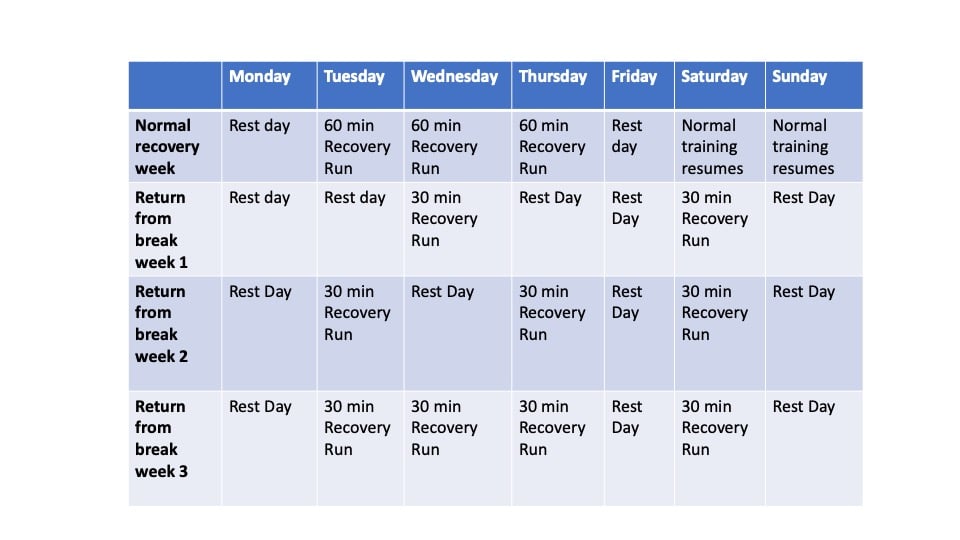
The Best Way to Return-to-Training Following Some Time Off
By Jason Koop,
Head Coach of CTS Ultrarunning
This summer and fall I had one objective in mind: to finish the Nolan’s 14 route in Colorado’s Sawatch Range. Sadly, I struck out on all three of my attempts there, the last one ending in quick fashion as I dislodged a rock and took a decent tumble down the mountainside. Fortunately, the ordeal was not all that bad and I escaped with only a few bumps and bruises, the largest of which were to my ego. Nonetheless, I was forced to take some time off to heal before getting back into running in earnest.
This forced break is similar to any other end-of-season down time, like many runners are facing this time of year. Regardless of whether your small break from running is a byproduct of an injury that needs to heal, a really big training block and race that you just need some space from, or any other lifestyle monkey wrench that has been thrown your way, you can use the pattern below–like I have–to get your groove back and get back into running.
Take some time
It’s OK to not run. There, you have permission. For many athletes, one, two, or even a few zero mileage weeks will be more beneficial in the long term than jumping right back into training. All too often we see athletes who are eager to get back into the swing of training forgo any sort of natural break. So, give yourself some time and space to rest without running, or even cross training for that matter. I use a two-pronged approach to determine the duration of an athlete’s substantial break, particularly after a long season or key race. Your break should be long enough that you should be both physically ready to run (you have no lingering soreness or injury) and psychologically ready to run (you actually want to run). Not one or the other, but both. Many athletes will find that the sweet spot to clear both of these checkpoints is between 2 and 3 weeks. Be patient and don’t worry, your fitness is not going anywhere.
Routine first
Once it’s time to get back into it, your first order of priority is to establish your routine. Many runners are creatures of habit, choosing to run at the same time each day. Your break from running disrupts that routine. Moring runners will tend to sleep in and afternoon runners will fill their days with extra work or chores (all admirable activities, to a certain extent). But, your return to running should start with establishing a routine. So, pick back up where you left off. If you were a morning runner, commit to waking up at same time each day (even if you are not going to run each of those days). Back up your bedtime accordingly in order to adjust. If you were an afternoon runner, commit to setting aside that time each afternoon. Even if you don’t run every day (more on that later), set aside the time in order to create the routine.
Build frequency, then single session volume
Now that you’ve reestablished your routine, it’s time to actually run. Once again, you should be in no hurry to build up to your peak of training volume. A good rule of thumb I use with my athletes is to spend 2 to 3 weeks at half of the frequency AND single session volume of a normal recovery week. For example, if your normal recovery week during the peak of training consisted of 5 days of 60-minute recovery runs, I would have that athlete do their first week of training back from time off with 2 or 3 days of 30-minute recovery runs. I then would build on one day of running each week until they got back to their normal frequency. Finally, each run can be built back up to a normal level of training. The key concept here is to build frequency first, then single session volume. Below is an example of athlete’s normal recovery week at the peak of training and then a 3-week return to running build following a one-month break from training.
► Free Ultrarunning Training Assessment Quiz
Take our free 2-minute quiz to discover how effective your training is and get recommendations for how you can improve.
Enjoying This Article? Get More Free Running Training Tips
Get our coaches' best training advice, delivered straight to your inbox weekly.
Don’t Overthink Your Training
Training need not be complicated, and that’s particularly true at this time of year. With athletes I’ve coached through comebacks, I’ve found they tend to get overwhelmed by a sudden return to highly structured and regimented training. Good comebacks, big and small, start simply. Establish your routine, slowly increase your frequency, then add time to each and every run. Done right, the break and subsequent ramp up will leave you refreshed, close to the same level of fitness you had before and ready to tackle whatever is next!



Comments 2
Great advice once again
Thanks, I needed that.
I’ve got close to another month. sigh 🙂